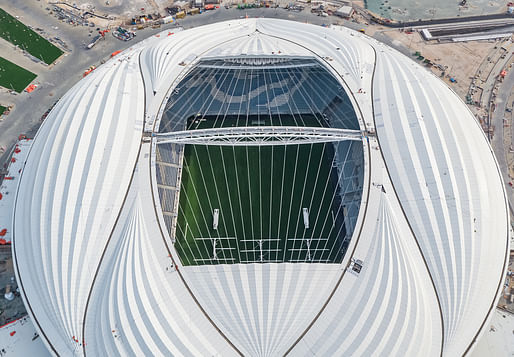

With the first big kick-off for the 2022 FIFA World Cup still more than three years away, the Zaha Hadid/Aecom-designed Al Janoub Stadium in Al Wakrah, Qatar recently hosted its inaugural soccer match with 40,000 fans and royal family members in attendance.
The stadium—not entirely uncontroversial since its conception in 2013—is the second fully operational venue for the 2022 tournament, following the Khalifa International Stadium redevelopment, and the first newly built site to host games for the 32 participating teams from November 21 through December 18, 2022.
"The client’s brief called for a 40,000-seat football stadium for the 2022 World Cup which could be reduced to a 20,000-seat capacity in its legacy mode following the tournament," explains the project description from Zaha Hadid Architects.
"20,000 seats is the optimum capacity for legacy use as the home ground to Al Wakrah Sport Club professional football team of the Qatar Stars national league. These temporary seats have been designed to be demountable and transported to a country in need of sporting infrastructure for post-tournament usage. Further temporary accommodation such as concessions are required for the additional capacity of FIFA World Cup tournament mode. This has been built as a temporary overlay outside the permanent footprint and enclosure of the stadium in its legacy mode."
"The stadium has an operable roof designed by Schlaich Bergermann Partner and a cooling system powered by solar harvesting that ensures the stadium can be used during Qatar’s summer months. The operable roof has been designed in sympathy with the cladding using pleated fabric and cables. When its deployed, the roof operates like a sail to cover the oculus above the field of play and create a sheltered environment for football during the summer. Passive design principles along with computer modelling and wind tunnel tests were used to maximise the effectiveness of the stadium enclosure to ensure player and spectator comfort."
"Given the stadium’s context within the coastal city of Al Wakrah, the client asked that its design reflect the maritime heritage of its location; in particular, the traditional boat of the region, the dhow. ZHA responded with a design that incorporates these cultural references in an abstracted manner and combines them with practical responses to the climate, context and the functional requirements of a football stadium. The abstraction transforms the literal into something new and appropriate for a football stadium; allowing multiple interpretations of these cultural references both in terms of how they are applied and how they are read."
"The stadium’s roof design is an abstraction of the hulls of dhows turned upside-down and huddled together to provide shade and shelter. This is expressed in the stadium’s envelope geometry, details and selected materiality, including the roof’s beam structure that echoes the interior structure of a dhow’s hull. The facades of the stadium are slanted outwards, tapered in elevation and reminiscent of dhow’s sail. The image of the dhow is further emphasized through the large overhang of the stadium’s eaves that incorporates strips of metal cladding echoing the timber structures used in a dhow."
"The stadium’s opaque roof and wall areas are expressed as pleated cross sections. This feature, which has its origins in Arabic motifs and calligraphy, adds texture to the outer shell and also emphasizes the stadium’s unique geometry. The external cladding materials are deliberately selected from a limited palette of materials and choice of colours; namely white for the roof and wall cladding, and darker colours for the areas below the eaves, including the lower level glazed walls with its ornamental lattice screen print that provides shading."
"The stadium sits on a large landscaped podium that takes visitors from grade to the entry level main entry concourse located at the middle of the seating bowl’s tiers. This podium connects the stadium into the adjacent landscape and reduces its scale. Large parabolic voids within the podium signify different activity zones. On the eastern side, voids allow for the majority of spectators to arrive and depart from the stadium. The north eastern void will include a community market whilst the south eastern void hosts an activity park. To the west, the parabolic void within the podium allows for vehicle access and drop off at grade for the players, officials and dignitaries."
Take a look at drawings and videos of the stadium's construction below.
Are you sure you want to block this user and hide all related comments throughout the site?
6 Comments
It looks like vagina sayers' assholes.
Still one of the funniest Daily Show bits ever: http://www.cc.com/video-clips/q9k5o3/the-daily-show-with-jon-stewart-unnecessary-muffness
I prefer the 70's version.
I wonder if anybody seen it with roof fabric drawn and how they interact with colder air rising? Fabric's housing helped to break away from the muff association used well at the JS show which belittled Zaha's persona, work, and architecture in general. Though, I didn't say it wasn't funny, the last skid with the sports reporter fucking with the stadium was hilarious.
What do you know about the physics of air? Please review your comment to avoid sounding ignorant.
Why don't you post some stuff from physics of air instead of jerking of to someones' typo?
Do you really understand what is being asked in my post? Did I ever claimed to be an expert on p-of-a other than speculating its possible form and function?
Does anyone here has a photo of the stadium with the ceiling fabric drawn? I looked a few sites but no luck. Material and design diverts water, traps the favorable air as much as possible, I am expecting something beautiful.
Archinect
This is your first comment on Archinect. Your comment will be visible once approved.